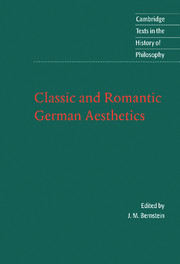Book contents
- Frontmatter
- Contents
- Introduction
- Chronology
- Further reading
- Note on the texts
- Aesthetica in nuce: A Rhapsody in Cabbalistic Prose (1762)
- Laocoön: An Essay on the Limits of Painting and Poetry (1766)
- From ‘On the Artistic Imitation of the Beautiful’ (1788)
- ‘Kallias or Concerning Beauty : Letters to Gottfried Körner’ (1793)
- ‘Oldest Programme for a System of German Idealism’ (1796)
- ‘Letter to Hegel, 26 January 1795’
- ‘Being Judgement Possibility’ (1795)
- ‘The Significance of Tragedy’ (1802)
- ‘Remarks on Oedipus’ (1803)
- From Miscellaneous Remarks (1797)
- ‘Monologue’
- ‘Dialogues’ (1798)
- ‘On Goethe’ (1798)
- ‘Studies in the Visual Arts’ (1799)
- From ‘Critical Fragments’ (1797)
- From ‘Athenaeum Fragments’ (1798)
- From ‘Ideas’ (1800)
- ‘On Goethe's Meister’ (1798)
- ‘Letter About the Novel’ (1799)
- ‘On Incomprehensibility’ (1800)
- Index
- Cambridge texts in the history of philosophy
From ‘On the Artistic Imitation of the Beautiful’ (1788)
Published online by Cambridge University Press: 05 June 2012
- Frontmatter
- Contents
- Introduction
- Chronology
- Further reading
- Note on the texts
- Aesthetica in nuce: A Rhapsody in Cabbalistic Prose (1762)
- Laocoön: An Essay on the Limits of Painting and Poetry (1766)
- From ‘On the Artistic Imitation of the Beautiful’ (1788)
- ‘Kallias or Concerning Beauty : Letters to Gottfried Körner’ (1793)
- ‘Oldest Programme for a System of German Idealism’ (1796)
- ‘Letter to Hegel, 26 January 1795’
- ‘Being Judgement Possibility’ (1795)
- ‘The Significance of Tragedy’ (1802)
- ‘Remarks on Oedipus’ (1803)
- From Miscellaneous Remarks (1797)
- ‘Monologue’
- ‘Dialogues’ (1798)
- ‘On Goethe’ (1798)
- ‘Studies in the Visual Arts’ (1799)
- From ‘Critical Fragments’ (1797)
- From ‘Athenaeum Fragments’ (1798)
- From ‘Ideas’ (1800)
- ‘On Goethe's Meister’ (1798)
- ‘Letter About the Novel’ (1799)
- ‘On Incomprehensibility’ (1800)
- Index
- Cambridge texts in the history of philosophy
Summary
The difference between the Greek actor imitating Socrates on the stage in Aristophanes' comedy and the wise man imitating him in everyday life is that these two cannot be comprised under one and the same description; thus we say that the actor parodies Socrates, while the wise man imitates him.
The actor was clearly not concerned with imitating Socrates truly, but was rather concerned with recreating his individual way of walking, his composure, his posture and his comportment in a heightened way in order to make him seem laughable. Because he does this intentionally and in fun we say he parodies Socrates.
But if the actor before us were not an actor but rather someone of the people who feels an inner closeness to him and now also imitates him in all seriousness, in his external characteristic as well, that is, in his walk, his posture and his comportment, we would say of this fool that he apes Socrates; or, he is to Socrates like the ape's posture and comportment is to the human.
The actor thus excludes the wise man and only parodies Socrates; for wisdom cannot be parodied: the wise man excludes Socrates in his imitation, and imitates wisdom in the wise man; for Socrates' individuality can well be parodied and aped, but not imitated. The fool has no sense for the wisdom but is driven to a sort of imitation; he grabs hold of what is closest to him, he apes so as not to be permitted to imitate [um nicht nachahmen zu dürfen]; he transposes the whole surface of another human being onto his own person; the basis or sense of self for this is provided by his foolishness.
- Type
- Chapter
- Information
- Classic and Romantic German Aesthetics , pp. 131 - 144Publisher: Cambridge University PressPrint publication year: 2002

